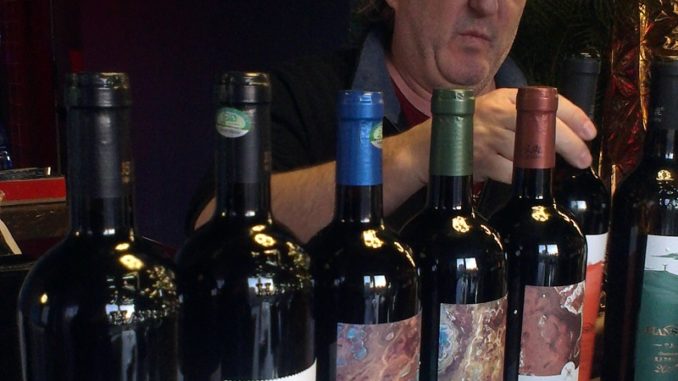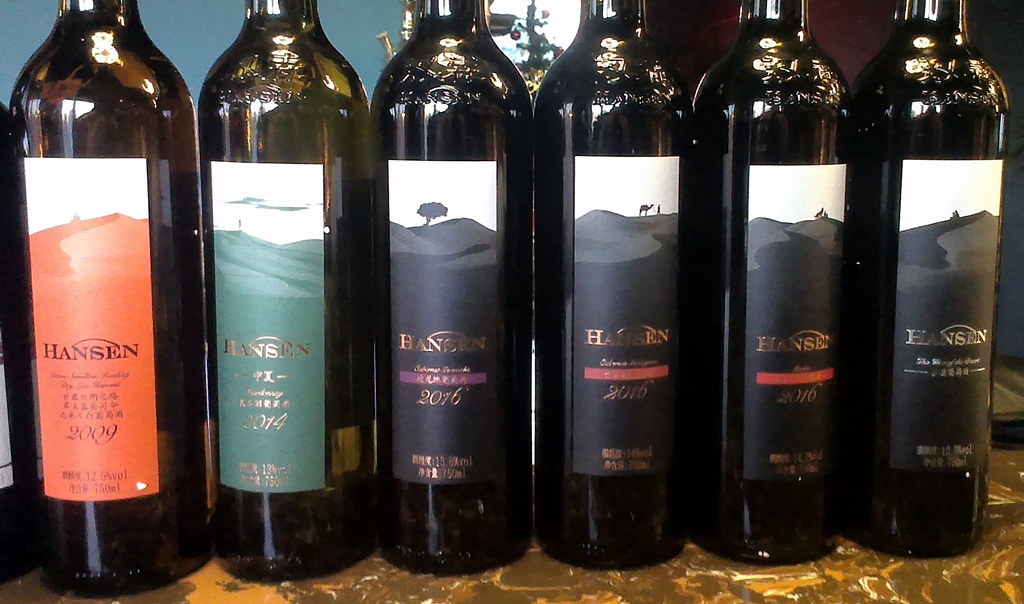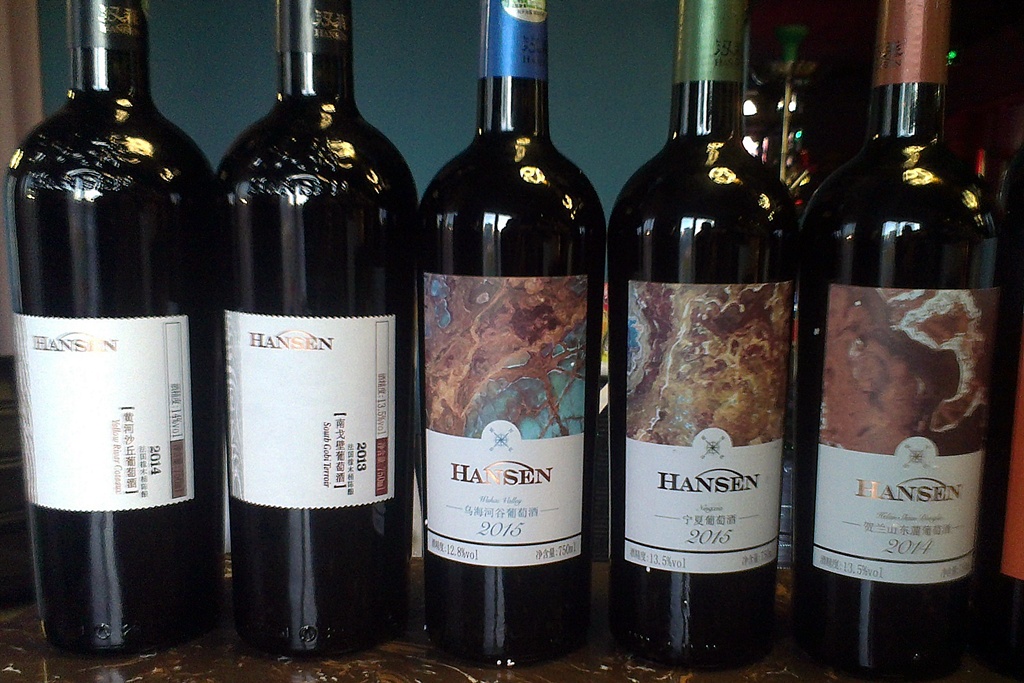
By Jim Boyce | Inner Mongolian winery Hansen ticked plenty of boxes during a portfolio tasting last Friday night in Beijing. While wine-makers in China typically add oak to their fruit like Donald Trump does ketchup to steak, nine of the eleven wines we tasted had no wood at all. The grapes did the talking with delicious results.
These wines also have moderate alcohol levels (peaking at 13.5 percent), are fairly priced for this quality (rmb150 to rmb300) and show regional variation—Hansen winemaker Bruno Paumard repeatedly pronounced “terroir!” If you are a fan of organic wine, Paumard says all eleven are certified, and are labeled with official stickers.
Cornered Market
Hansen is in Inner Mongolia, just across the Yellow River from the much better known Ningxia region, a slight isolation that gives it a major advantage. While Ningxia has dozens of capable wineries, it has a relatively small market of 6.5 million people, a third of which are Hui Muslim. Given this, it needs to find buyers beyond its borders.
In contrast, Hansen has little competition in its far larger home region of 25 million people. Paumard says the winery sells between 3 and 4 million bottles per year, over 80 percent of that just in Inner Mongolia.
That’s not to ignore the importance of Ningxia. Hansen has an operation at Hongsipu, south of Ningxia’s regional capital Yinchuan. It also sources grapes from better-known areas near the Helan Mountains, home of Ningxia’s most famous wineries. But Hansen does seem to have the best of both worlds: it’s in a position both to make good wine and to sell lots of it.
A “New Frontier”
Paumard is so confident about his most recent vintages that he says Hansen has established a “new frontier” for Chinese wines. He cites a focus on putting the fruit first, on making regional-specific wine and, crucially, on changing the mindset at the winery where he has worked for seven years. He says many Chinese winemakers come from universities that stress process above all, partly because they had few local wineries to serve as examples, especially in terms of quality.
“At the beginning, Hansen hired those people, and they used very heavy labor-intensive processes,” he said. “Where I now filter once, they used to filter four times.”
He has slowly but steadily shifted to far less intervention, with telling results. I’ll post separately about this issue but for now let’s get to the wine. (Note: prices are the retail rate suggested by Paumard.)

“Sweet Spice”
Of the entry-level wines (rmb150), I liked the Merlot 2016 best. The nose is fresh and mildly fruity with a touch of coffee / chocolate and green pepper. This wine is lush and fruity, with a slightly spicy finish, what Paumard called “sweet spice”. It’s the kind of wine anyone from a novice to an aficionado would enjoy.
I was curious about the entry-level Cabernet Gernischt—some call it “China’s grape”—as Hansen has done it well before. This one needed time to wake up. It had a smoky preserved plum smell. Light and fruity, and easy to gulp, it avoided the heavy oak and pronounced green pepper found in many other Gernischts. The vines were only planted in 2012, so it will be fun to try future vintages.

“Terroir” Wines
The second-tier (rmb250) included what Paumard stressed are “terroir” wines. The Cabernet Sauvignon 2014 uses fruit from near the Helan Mountains. It smells of black currant, with touches of smoke and dry grass. It’s ripe and juicy, with vibrant “chewy” fruit. It should be of interest to those who already have wineries in those parts.
I also liked the Cabernet Sauvignon (90%)-Cabernet Gernischt (10%) from Wuhai in Inner Mongolia. It smelled of cherry / plum and of something sweet like tanghulu (candied hawthorne). A juicy and playful junior counterpoint to the Helan Mountain wine.
Regional Wines
Finally, there were two wines that used oak, though in restraint.
The South Gobi Cabernet 2013 had dark salty plum, black olive and smoky aromas. Medium-bodied, with refreshing dark fruit, and a bit of a “gun-metal” character at the finish. Fruit from both Hongsipu and the Helan Mountain foothills was used.
The last wine, and biggest of the day, was Yellow River Cabernet, with 50 percent new oak. Intense black jammy fruit, with slight coal and dry grass aromas, greets the nose. It’s just as powerful in the mouth: voluptuous.
We tried a few more. Bruno’s favorite was the Chardonnay. And he continues to push a dry late-harvest Semillon-Riesling made with grapes from Gansu—”it’s Bordeaux and Alsace together!” That one smells like honey and summer flowers, with a hint of diesel, but the expected sweetness isn’t there and it tends to be a love-it or hate-it wine.
In any case, a most revealing tasting. I’ve only been to Hansen once, three years ago with Andrew Jefford of Decanter and Anthony Rose of The Independent. Arriving from Ningxia, Hansen seemed positively eccentric, as Paumard explained his philosophy and shared many wines-in-the-works in his cellar. Three years later, he has a new lineup and is ready to proclaim a “new frontier”. Let’s see if others agree!
Follow Grape Wall on Facebook and Twitter. Support the project here. And sign up for the China wine newsletter below. Also check out sibling sites Beijing Boyce and World Baijiu Day.
Sign up for the Grape Wall newsletter here. Follow Grape Wall on LinkedIn, Instagram, Facebook and Twitter. And see my sibling sites World Marselan Day, World Baijiu Day and Beijing Boyce. Grape Wall has no advertisers, so if you find the content useful, please help cover the costs via PayPal, WeChat or Alipay. Contact Grape Wall via grapewallofchina (at) gmail.com.
Leave a Reply
You must be logged in to post a comment.